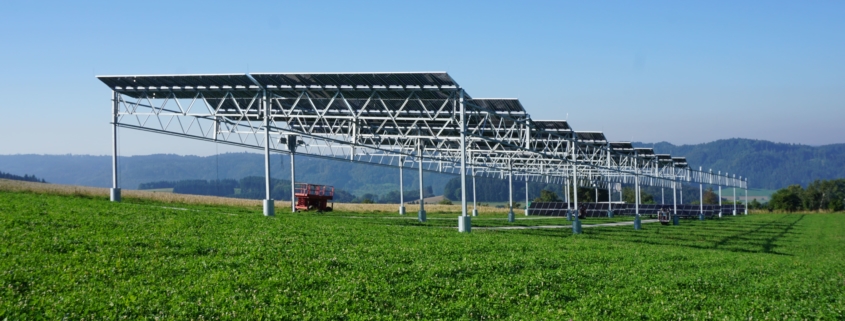
Agrophotovoltaics – Solar systems on agricultural land as a solution for energy and food supply
BACKGROUND: CLIMATE CHANGE, RENEWABLE ENERGIES & FOOD PRODUCTION
For years, the sustainable energy transition has been on the list of priorities in Germany. Especially in the context of this year’s Renewable Energy Sources Act 2021 (EEG 21) and our increasing electricity consumption, scalable, renewable, and clean energy sources are of utmost importance. Our goal as a society in Germany is to achieve climate neutrality by 2050 at the latest. To achieve this, 65% of our energy should already come from renewable sources by 2035.
The production of solar energy is to be heavily expanded under the EEG 21 – and even go beyond the original goals of the Climate Protection Plan 2030.
Solar energy is indeed a renewable resource and therefore sustainable and necessary. Nevertheless, we have repeatedly noticed problems that one is confronted with when scaling up photovoltaic systems. Since only unsealed land may be used for solar parks, land competition with agricultural land is more and more present.
Agricultural businesses are also under increasing pressure from the growing population and the consequences of climate change. More food must be produced under more difficult conditions on shrinking land. Farms are often no longer able to produce under economic conditions and are also exposed to climate-related increases in weather extremes such as drought, hail, or heavy rain.
INNOVATION: AGROPHOTOVOLTAICS
To find a sustainable solution that supports the energy transition solves the issue of land competition and the difficult situation of farms, we have joined forces as an innovation consultancy with experts from the solar industry and agriculture. There is a way to produce energy and food at the same time while supporting farms economically: Agrophotovoltaics (APV).
After an intensive research phase and a test plant of our partners and the Frauenhofer ISE, we founded the company AgroSolar Europe together with HilberSolar, experts in solar plants and agriculture. Our system is adapted to the needs of farmers and is 100% compliant with legal regulations and partly patented. The AgroSolar system is ready for the market at this stage and ready to be scaled up. Moreover, our systems are fully adapted to the needs of farms: They are 100% compliant with legal regulations and, thanks to our patented and unique substructure, de-constructible as required by the DIN standard.
POTENTIAL: APV FOR AGRICULTURE, SOCIETY & ENVIRONMENT
This technology, also called agriphotovoltaics, combines solar energy and food production on the same surface. Solar panels are installed at a height of several metres, and a distance between them, above the agricultural land. In this way, crops can continue to be grown and agricultural machinery can easily move underneath. Land use efficiency is significantly increased, also because the agro-PV system has a protective effect on the plants: Crops are protected from climate-related weather extremes and soil moisture is increased due to increased shade and the resulting lower temperatures. On the one hand, this leads to a saving of up to 20% water, and on the other hand, the quality of the arable soil is increased. The minimised wind erosion and generally increased soil moisture lead to a better humus build-up. This also creates a microclimate that has a positive effect on biodiversity. In addition, after a few years of use of the plant, more CO2 is stored in the soil due to the humus build-up.
The benefits for farms are broad, as income is diversified, and the farm is made more resilient for the future. The environment and society also benefit from the positive ecological, social, and economic consequences: If agri-PV systems were installed on just 4% of Germany’s arable land, Germany’s current electricity needs could be met.
But an agro-PV system can also have important positive impacts for rural districts, communities, or municipalities because the system enables decentralised access to energy. Particularly in our time, when more and more electricity-powered machines and vehicles are being used even in rural areas to combat climate change, energy autonomy is a great advantage: municipalities, cities, communities, or counties can join forces and work for local, decentralised, sustainable and, above all, future-proof energy.
In addition to the many ecological and economic advantages, we see great potential for the future, especially in agricultural automation and digitalisation. Therefore, we are constantly working on robotics and automation processes that can additionally be integrated into the APV system. These should contribute to improved resource utilisation and ecological and economic security in the future.
You might also be interested in this: Robots in agriculture – how AI food robots can optimise the food supply
Sources:



